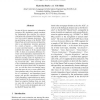Free Online Productivity Tools
i2Speak
i2Symbol
i2OCR
iTex2Img
iWeb2Print
iWeb2Shot
i2Type
iPdf2Split
iPdf2Merge
i2Bopomofo
i2Arabic
i2Style
i2Image
i2PDF
iLatex2Rtf
Sci2ools
111
click to vote
EMNLP
2010
2010
Evaluating the Impact of Alternative Dependency Graph Encodings on Solving Event Extraction Tasks
In state-of-the-art approaches to information extraction (IE), dependency graphs constitute the fundamental data structure for syntactic structuring and subsequent knowledge elicitation from natural language documents. The top-performing systems in the BioNLP 2009 Shared Task on Event Extraction all shared the idea to use dependency structures generated by a variety of parsers -- either directly or in some converted manner -- and optionally modified their output to fit the special needs of IE. As there are systematic differences between various dependency representations being used in this competition, we scrutinize on different encoding styles for dependency information and their possible impact on solving several IE tasks. After assessing more or less established dependency representations such as the Stanford and CoNLL-X dependencies, we will then focus on trimming operations that pave the way to more effective IE. Our evaluation study covers data from a number of constituency- and...
Dependency Representations | EMNLP 2010 | Event Extraction | Natural Language Processing | Various Dependency Representations |
| Added | 11 Feb 2011 |
| Updated | 11 Feb 2011 |
| Type | Journal |
| Year | 2010 |
| Where | EMNLP |
| Authors | Ekaterina Buyko, Udo Hahn |
Comments (0)

